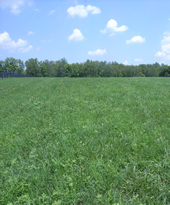Assessing Pasture: Forage Identification

When planning a grazing management plan for your pastures, it’s important to realize that pasture is the most economical and efficient way to feed your animals. When managing pasture, both the animal nutrient needs and pasture requirements should be considered. To start, begin by identifying the forage species in a pasture. Next, estimate how much of it is there. During most of the spring and fall in Kentucky, you will find cool-season grasses along with some legumes.
Kentucky Bluegrass can be identified by its signature mark of the boat shaped tip at the end of the blade. KY Bluegrass is a thin, upright grass that has a rolled stem at the base of the plant, and forms a dense sod, almost like a mat. You may also notice it before other cool season grasses as it typically seeds sooner than orchardgrass or tall fescue.
Tall Fescue is one of the most prominent forages in Kentucky, and one of its most obvious forms of identification is the feel of the blades. The blades of Kentucky 31 Tall Fescue, the most prevalent variety, are very rough and thick feeling, particularly if you slide your hand down the plant toward the base. The base is a rolled stem, and has a prominent auricle where the leaf attaches to the stem. Tall fescue is a bunch grass, and tends to grow straight up from the base of the plant.
Orchardgrass is also a bunch grass, but has a softer, smoother feel than tall fescue. It is more of a flexible and pliable grass. It is also one of the few plants to have a flat stem at the base, making it easy to identify. While color may vary slightly, orchardgrass looks more of a lighter gray/blue green, while tall fescue tends to be a darker green. This species will typically only persist in a stand for 5 or 6 years, as it is less tolerable to heavy grazing.
White Clover and Red Clover can appear very similar at first glance but have very distinguishable features setting them apart. While both are clovers with true trifoliate leaves, white clover produces a white flower while red clover produces a red bud. Red clover also has hairs on the stem, and white clover does not. White clover tends to grow smaller leaves closer to the ground, while red clover will grow a bit more upright producing larger leaves. White clover also has stolons, or underground runners, which allow the plant to grow more horizontally and cover more surface area.
Perennial Ryegrass is another cool season grass you may see in your pasture. Perennial ryegrass can look similar to tall fescue, but the grass has a smoother, thinner leaf. Also, this grass tends to have a glossy sheen at times. This grass is less persistent than most cool-season grass, as it is less winter hardy and not very drought tolerant.
After identifying grasses in your pastures, it will be much easier to create a grazing management plan. Be sure to consider animal nutrient requirements, species and quality of pasture grasses, amount of weeds and bare soil, and stocking rates when making decisions regarding pasture management. Your local county extension agent can assist you with managing your pasture effectively.
Contacts
Kelly Kramer
804 W.P. Garrigus Building
University of Kentucky
Lexington, KY 40546-0215
Kelly.kramer@uky.edu
(859) 257-7512
Northern Kentucky Pasture Walk Contacts:
Don Sorrell (Campbell)
(859) 572-2600
Daniel Allen (Kenton)
(859) 356-3155
Michael Mann (Pendleton)
(859) 654-3395
Chris Ammerman (Grant)
(859) 824-3355
Jerry Brown (Boone)
(859) 586-6101
Western Kentucky Pasture Walk Contacts:
Curt Judy (Todd)
(270) 265-5659
Jay Stone (Christian)
(270) 886-6328 X110
Categories:
General
Species/Varieties


